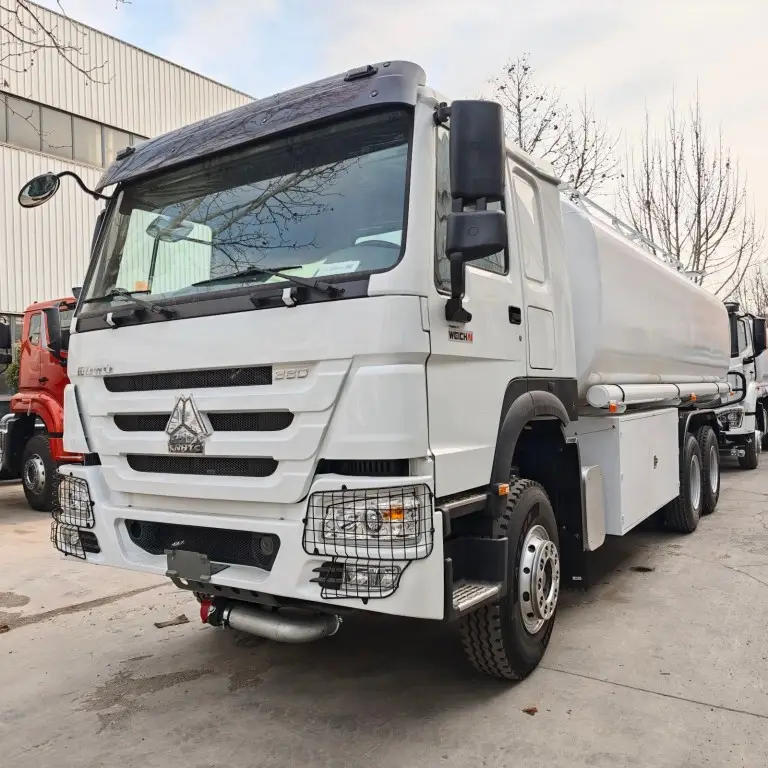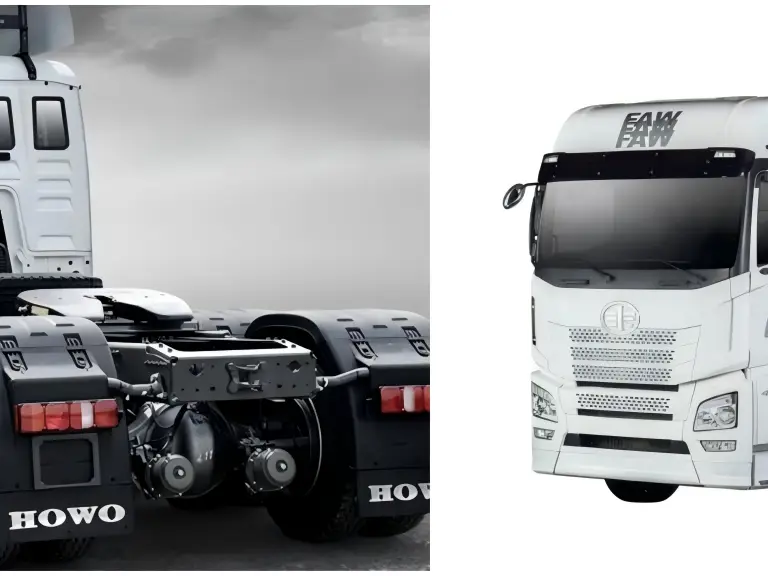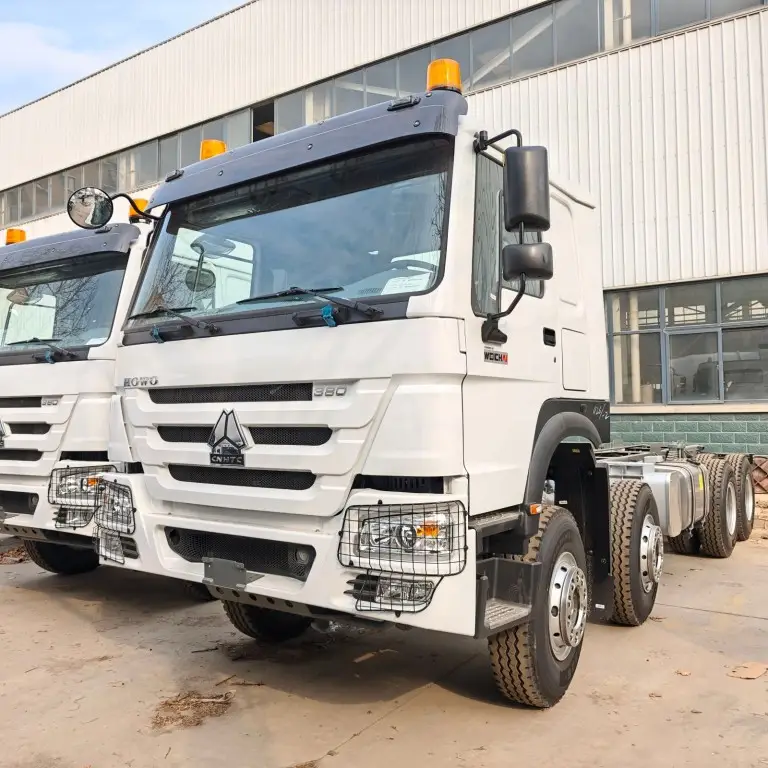Owning a Sinotruk HOWO truck gives you strong logistics power. These trucks are built for tough conditions. This includes the HOWO 371 dump truck in mining areas. It also includes the A7 tractor on highways.
Many fleet managers see maintenance as a cost to cut. This is a dangerous mistake. This guide is more than a basic user manual. It uses our years of repair data. We give you a detailed and useful maintenance plan with real-world tips.
Table of Contents
Key Mileage and Maintenance Cycle Quick Guide
Project | First Maintenance | Daily/Weekly Checks | Regular Maintenance Interval | Heavy Load/Tough Conditions Advice |
|---|---|---|---|---|
Engine Oil + Oil Filter | 2,000-4,000 km or 3-6 months | Daily level | 10,000 km or 8 months | 5,000-8,000 km |
Fuel Filter | 2,000-4,000 km | – | Check 10,000 km, replace 20,000 km or 14 months | 10,000 km |
Air Filter | Clean every 4,000-5,000 km | Check indicator | Replace 18,000-20,000 km or 14 months | Check every 10,000 km |
Transmission Oil | Check 2,000 km, first change 2,000-5,000 km | – | 50,000-60,000 km or 10 months | 30,000-40,000 km |
Axle Oil (Middle/Rear Axle) | First change 5,000 km | – | 60,000 km or 10 months | 40,000-50,000 km |
Brake System Air Pressure | – | Daily | Adjust every 9,000-30,000 km | Daily drainage + weekly checks |
Coolant | Check 2,000 km | Daily level | Replace 34,000-36,000 km or by inspection | Annual change |
Steering Assist Oil | First change 2,500 km | Daily level | Every 20,000 km or 6 months | 10,000-15,000 km |
Brake Oil (DOT-3/4) | – | – | Every 100,000 km or 2 years | Annual check |
First Maintenance
Sinotruk requires the first service within 2,000-4,000 km. It can also be done 3-6 months after purchase. This is based on the newest manual. Some older manuals say 1,500-3,000 km. Among Genron’s clients, 90% of early engine issues come from skipping this first service. These problems include noise and oil burning. This step removes factory residues and sets a baseline for checks. So, you must complete these tasks in the first maintenance:
- Replace engine oil and oil filter. This removes metal bits. Use CH-4 15W/40 oil. The capacity is about 23 liters.
- Replace or clean the fuel filter and pre-filter. This ensures the fuel is clean.
- Check and tighten all visible bolts. This includes the cylinder head, connecting rods, axle housing, steel plates, and U-bolts.
- Adjust the valve clearance. The standard values for WD615/WP10/WP12 engines are: intake 0.3-0.4 mm, exhaust 0.4-0.6 mm.
- Check and tighten drive shaft bolts. The torque should be 650-750 N·m. Retighten at 3,000 km after the first 1,200 km.
- Replace axle oil. The middle and rear axles must be changed the first time. This removes metal shavings from manufacturing. Use GL-5 85W/90 oil. The middle axle needs 18 liters. The rear axle needs 14.5 liters.
- Check steering system play. Lubricate all grease nipples. Do the first change of the steering assist oil. Use ATF III. The capacity is 5 liters.
- Check brake system clearance. Drain water from air tanks. Check the wear on the brake shoes.
- Check the battery fluid level. Check lights, tire pressure, and electrical wires. Check the battery terminals.
- Inspect the air filter body and safety filter element. If anything is wrong, clean or replace it right away.
- Check that all electrical indicator lights work. This includes the oil pressure, air pressure, and charging lights.
- Check belts and hoses for cracks, looseness, or aging. Adjust the belt tension.
- Test the parking and foot brake systems. Make sure there are no strange noises or scraping sounds.
Daily/Weekly Check List
We ask all drivers to do these checks every day. They should be done before starting the truck. They take less than 8 minutes. These simple checks can find dangers early. This includes low fluid levels or worn parts. This helps keep driving safe.
- Dipstick: Check with a cold engine. The level should be between the upper and lower marks. If it is below the lower mark, add oil right away. This prevents the engine from running dry. Check for leaks.
- Coolant: The level in the expansion tank should be between MIN and MAX. Do not open the radiator cap when it is hot. Look for signs of dirt often. The concentration should be 40-60%. The freezing point should be -25°C to -60°C.
- Brake air tanks: Drain them daily. In hot areas, do it once in the morning and evening. This stops freezing and rust. Also watch the brake fluid level. This avoids brake failure from dirty fluid. Keep air pressure at 650-850 kPa.
- Tire pressure: The tractor’s front wheels should be 850-900 kPa. The rear wheels should be 850-950 kPa. See the label on the cab door frame. Check for uneven wear or damage. Check for rim damage. Rotate tires as needed. Tighten tire nuts to the right torque.
- Lights, horn, wipers, rearview mirrors: Make sure all electrical parts work right. Check indicator lights like oil pressure, air pressure, and charging lights. Make sure they are not lit when they shouldn’t be.
- Air filter maintenance indicator: If the red mark shows, clean the filter right away. Also, quickly check the steering assist oil and transmission oil levels.
- Brake system: Test the foot brake and parking brake. Listen for any odd sounds, sponginess, or scraping. If you notice any, stop and get it repaired. Check the brake lines, chambers, and pedal travel.
- Belts and hoses: Look for cracks or looseness. Replace them early to prevent them from breaking suddenly.
- Steering system: Turn the steering wheel. Check for oil leaks or unusual resistance. Make sure the hydraulic oil temperature is in a safe range. Check the assist oil level.
- Other leaks: Check carefully for signs of oil, water, or air leaks. Check the engine, chassis, and electrical wiring.
Routine Maintenance Items
Regular maintenance is vital for HOWO trucks. It helps them perform well in all conditions. The following sections explain the steps for each maintenance area. We start with key parts like the engine, transmission, and axles. We also cover the steering and brake systems. This helps you fully manage your truck’s health. It will extend its life and lower your running costs.
Engine Maintenance
The engine is the main power source of HOWO trucks. Good maintenance can greatly improve its life and efficiency. Our experience shows that ignoring any item can cause a chain of problems. These can include overheating or dirty fuel.
Oil choice and change cycle :
- Highway normal use: Use CH-4/CI-4 15W-40 oil. Change it every 10,000 km or 8 months. For heavy loads, change it every 5,000 km to match the actual wear. The capacity is 23 liters.
- Africa/Middle East dusty heavy loads: Use CI-4/CJ-4 10W-40 oil. Change it every 5,000-8,000 km. This is our best value from real-world data. Change the oil filter at the same time.
Fuel system: Clean the coarse filter (oil-water separator) every 10,000 km. Replace the fine filter every 18,000-20,000 km. Use Euro III or higher diesel. Its sulfur content should be ≤350 ppm. This keeps the fuel pure and free of dirt. It prevents clogged injectors or poor engine performance. Also check the turbocharger bearing clearance.
Cooling system maintenance: Check the coolant level every day. Keep it in the set range. A low level might mean a leak. You should check for it right away. We suggest a full flush and coolant change every 34,000-36,000 km. The capacity is 40-45 liters. Use coolant that meets the ASTM D3306 standard. In tough places like hot areas, change it yearly. This ensures good cooling and prevents corrosion. If the coolant turns brown or cloudy, change it right away.
Transmission, Axle, and Steering System Maintenance
These parts handle heavy loads. Regular maintenance can lower friction and failures.
- Transmission oil: HW19710/19712 series use GL-5 85W/90 oil. The capacity is 12-12.5 liters. For new trucks, the first change is at 2,000-5,000 km. After that, change it every 50,000-60,000 km or 10 months. Check the oil level at the first 2,000 km. This ensures the level is right and prevents heat damage.
- Middle and rear axle oil: You must change it first at 5,000 km. This is an official rule. Use GL-5 85W/90 oil. The middle axle takes 18 liters, and the rear axle takes 14.5 liters. Then, change it every 60,000 km or 10 months. We suggest every 40,000-50,000 km for heavy loads. Do not fill past the filler plug. This avoids overflow leaks. Check if the breather plug is blocked. Check if the half-shaft bolts are loose.
- Steering system: Check the power steering oil tank daily. Use ATF DEXRON III oil. The capacity is 5 liters. The first change is at 2,500 km. Then change it every 20,000 km or 6 months. Check the machine and oil lines for leaks. If the front wheels are not aligned, lubricate the steering knuckles and kingpins. Do this every 400 hours with No. 2 lithium grease. If you find leaks or odd oil temperature, stop and get it fixed. This ensures steering safety.
Brake System Maintenance
The brake system is vital for your safety. You cannot ignore any small issues.
- Drain water daily. Keep air pressure at 650-850 kPa.
- Keep brake pad clearance at 0.6-0.8 mm. Adjust it every 9,000-30,000 km. For the front axle, tighten then loosen by 4 turns. For the rear axle, use 3 turns. Check brake pads and shoe linings for wear. Replace them when needed. Replace shoe linings every 50,000 km.
- In cold areas, you must install an alcohol automatic evaporator. Replace the air dryer every 18 months.
- When adding brake fluid, make sure the level is in the standard range. Look for dirt or bubbles. Use DOT-3/4 fluid. The capacity is 0.5 liters. Replace it every 100,000 km or 2 years. If you hear scraping or feel unstable braking, stop and get it fixed. This avoids accident risks. Check brake chambers and lines for air leaks. Perform tests for braking force balance and efficiency.
Cooling System and Rust Prevention
- The coolant should be a -35°C long-life ethylene glycol type. The concentration should be 40-60%. A full change is needed every 34,000-36,000 km.
- In hot African regions, we suggest changing it every year.
- Clean the outside of the radiator each month. Use compressed air with pressure ≤300 kPa.
- For rust prevention, clean the chassis and wheel arches often. Use good rust-proof coatings. Spray an oil-based protector every 6-12 months. This fights humidity and salt damage. Check the exhaust system installation. Check for loose shock absorbers and rubber bushings.
Lubrication Points Quick Guide (Do every 2 weeks or 2,000-5,000 km)
Lubrication is key to reducing wear. Using the greases listed in the manual can extend part life by 20% or more.
Lubrication Position | Grease Type | Reference Amount |
|---|---|---|
Water Pump Bearing | No. 2 Lithium Grease | 120 g |
Kingpin, Steering Knuckle | No. 2 Lithium Grease | As needed |
Drive Shaft Cross Universal Joint | No. 2 Lithium Grease | To overflow |
Wheel Hub Bearing (New Vehicle) | No. 2 Lithium Grease | 0.6 kg per side |
Clutch Release Bearing | High-Temperature Lithium Grease | As needed |
Rear Axle Reducer | GL-5 85W/90 | To filler plug position |
Front Axle Brake Arm/Camshaft | No. 2 Lithium Grease | As needed |
Leaf Spring Pin | No. 2 Lithium Grease | As needed |
Conclusion
As a professional supplier of HOWO trucks, Genron knows their strength and reliability are key to your success. We have provided you with a full and practical solution. It covers everything from daily checks to detailed service intervals. It also includes maintenance plans for key systems. This will help you avoid common failures. It will lower your running costs and extend your truck’s life.
Years of experience show that ignoring small issues often leads to high costs. But HOWO trucks that follow strict maintenance can easily reach one million kilometers of great performance. Whether you’re maintaining your current fleet or exploring HOWO trucks for sale, we hope this guide helps your fleet stay efficient.
If you need original parts or official manuals, please contact the Genron team. You can also contact us to customize your HOWO truck. We are always here for you. We provide professional support and helpful advice. We want to help your career run smoothly.
FAQ
How soon should the first service be done for a new truck?
According to Sinotruk’s official rules, a new truck needs its first service within 2,000-4,000 kilometers of driving. It can also be done 3-6 months after purchase.
How often should oil be changed in dusty parts of Africa?
Based on our years of experience, we suggest changing the oil every 5,000-8,000 kilometers. This is safer than the official standard.
What is the most common reason for weak brakes?
The most common reason is not draining water from the air tanks on time. The next reasons are air dryer failure or line leaks.
Can ordinary oil be used instead?
Absolutely not. You must use CH-4/CI-4 level or higher diesel engine oil. If not, it can cause bad wear in just 3 months.





